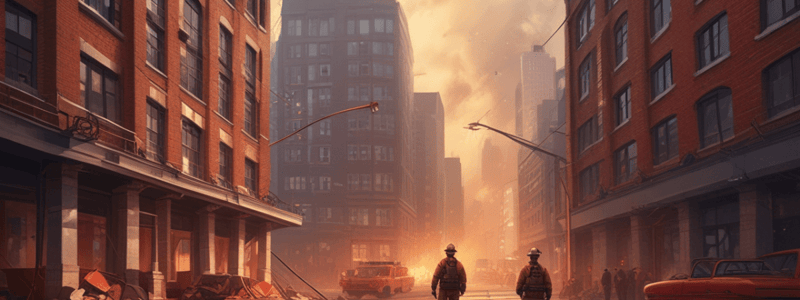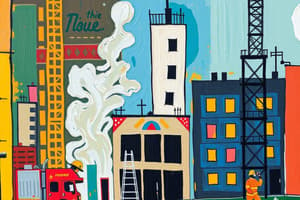Podcast
Questions and Answers
What is the primary factor that affects how wood reacts to fire conditions?
What is the primary factor that affects how wood reacts to fire conditions?
- Method of lumber milling
- Type of tree (old growth or new growth)
- Moisture content
- Size and moisture content (correct)
Which of the following materials is most likely to prevent or limit the spread of fire?
Which of the following materials is most likely to prevent or limit the spread of fire?
- Glass/fiberglass
- Composite or engineered materials
- Wood
- Concrete (correct)
What is the purpose of using gypsum drywall or other insulation in building construction?
What is the purpose of using gypsum drywall or other insulation in building construction?
- To reduce the risk of fire
- To protect lumber from heat or fire (correct)
- To increase the structural integrity of wooden beams
- To enhance the aesthetic appeal of the building
What is the main component of many structural assemblies in North America?
What is the main component of many structural assemblies in North America?
Which type of lumber is likely to be denser and structurally stronger?
Which type of lumber is likely to be denser and structurally stronger?
What happens to the structural integrity of large wooden beams when exposed to direct flame?
What happens to the structural integrity of large wooden beams when exposed to direct flame?
What is the primary purpose of understanding building materials and their reactions to heat?
What is the primary purpose of understanding building materials and their reactions to heat?
What is the term for materials that are made from a combination of natural and synthetic materials?
What is the term for materials that are made from a combination of natural and synthetic materials?
Flashcards are hidden until you start studying
Study Notes
Building Materials
- A wide variety of materials are used in building construction, including wood, metals, gypsum, glass/fiberglass, and composite or engineered materials.
- Each material reacts differently to heat exposure, and understanding these reactions is crucial for firefighting operations.
Wood
- Wood is the most common building material used in North America and is a main component of many structural assemblies.
- The size and moisture content of wood affect its reaction to fire conditions.
- Larger wooden beams, like those used in heavy-timber construction, are difficult to ignite and retain structural integrity even after prolonged exposure to direct flame.
- Smaller wood dimensions are easier to ignite and lose structural integrity faster.
- Lumber from naturally grown trees is generally denser and structurally stronger than lumber from farmed trees.
- Wood with high moisture content (green wood) does not ignite as readily nor burn as fast as kiln-dried or dehydrated wood.
- Pressure-treated wood with fire-retardant chemicals can reduce the speed of ignition or burning, but is not fully effective in reducing fire spread.
Other Building Materials
- Concrete and masonry materials, like reinforced concrete and lath and plaster, can prevent or limit fire spread.
- Metals, gypsum, glass/fiberglass, and composite materials have unique reactions to heat and fire.
Studying That Suits You
Use AI to generate personalized quizzes and flashcards to suit your learning preferences.




